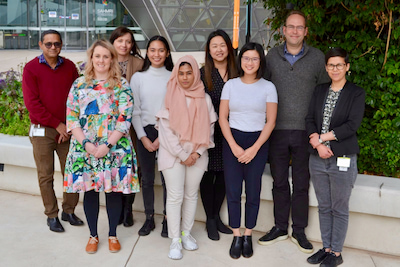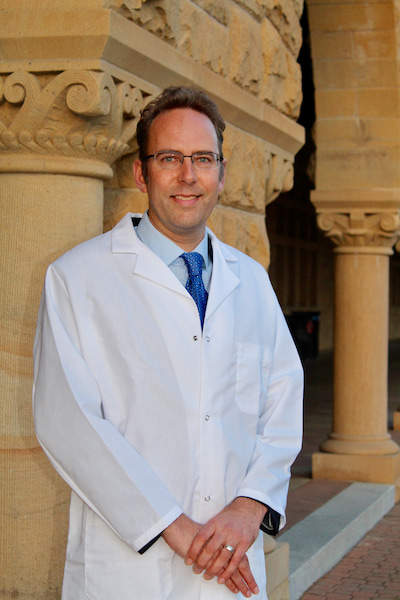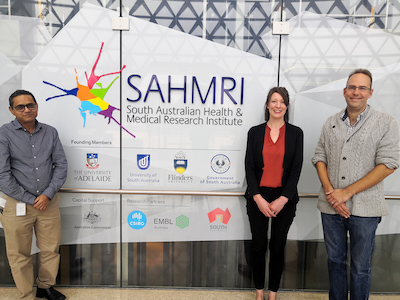Aim of first-ever CMML study – to improve survival
A lot of ‘world firsts’ are involved in an Australian clinical trial that is taking a precision medicine approach to treating CMML, a neglected and serious rare blood cancer that is poorly understood.
“No one’s done a comprehensive trial with mutation-specific therapies for this disease before,” says Associate Professor Dan Thomas, clinical haematologist and leader of the Myeloid Metabolism Laboratory in the Precision Medicine Theme at the South Australia Health and Medical Research Institute, Adelaide.

Chronic myelomonocytic leukaemia (CMML) has been “bunched into myelodysplasia” and included in MDS trials, even though MDS-type treatments “don’t really work that well” for this disease. In fact, some cases of CMML have features of a myeloproliferative neoplasm (MPN) with high white cell count and enlargement of the spleen.
“MDS/MPN overlap diseases don’t fit neatly into any single category, so often miss out on clinical trials or new treatments,” said Dr Thomas.
“The Leukaemia Foundation has championed the idea of thinking about blood cancers as a whole, to increase awareness and appropriate treatment funding, and then looking at what’s being neglected. That was part of the State of the Nation: Blood Cancer in Australia report that came out in 2019,” said Dr Thomas.
“CMML is a classic example of something that’s been missed because it’s been almost dwarfed by myelodysplasia and by AML. But if you look at the cells and you look at the mutations, CMML is a separate disease, with its own biology, and it needs its own specific treatments.
“That’s why we’re doing this trial. It’s an Australians-only trial and the first of its kind,” said Dr Thomas.
He and Dr Devendra Hiwase, together with Associate Professor David Ross, are the coordinating investigators of the trial, called PREACH-M – Precision Medicine for Chronic Myelomonocytic Leukaemia: A phase II trial studying the efficacy of lenzilumab and high dose ascorbate with azacitidine based on molecular profiling.
“This study will assess the impact of new combination therapies in specific molecular subgroups of CMML and whether treatment response can be improved by targeting certain mutation subgroups,” Dr Thomas explained.
“It will help us answer a lot of questions and move Australia toward cutting edge cancer therapies, as well as giving patients access to cancer sequencing for free.”
What is CMML, how is it diagnosed and treated?
About four in a million Australians are diagnosed each year with CMML, a clonal stem cell disorder with features of both MDS and MPN. It also has a risk of transforming to AML.
CMML most commonly occurs in older adults with the median age, 65-75 years. The prognosis, with a median overall survival of 30 months, has remained essentially unchanged over the last 30 years.
Therapeutic options in Australia for CMML are limited. Azacitidine (Vidaza®) is the only approved treatment for a select population of patients (those that most resemble MDS), and while allogeneic stem cell transplantation (ASCT) is a potentially curative therapy, only a minority of people with CMML are eligible for ASCT.
Dr Thomas said more than 90% of CMML cases carry recurrent mutations that “we are targeting in this trial”.
These are the most common – TET2 and RAS pathway mutations (KRAS, NRAS or CBL).
“At least one third of CMML patients in Australia have an unusual subtype of the disease where their blood cell count is high, and it does not fit under MDS criteria. These people are not eligible to access azacitidine on the Pharmaceutical Benefits Scheme,” Dr Thomas said.
“I’ve always wanted to do something for this disease [CMML] since I was a medical student and the lab was developing growth factor blocking drugs in Adelaide that were showing good effects on CMML in pre-clinical experiments by Dr Peter Bardy and Dr Hayley Ramshaw.
“It’s a mysterious disease because the cytogenetic profile is often very normal. CMML can present insidiously, with slightly high monocyte count which you may not even register as something to worry about, and many doctors wouldn’t know their patients even had it until it’s too late.
“A lot of these patients get picked up with a fever of unknown origin or a suspected chronic infection giving them a slightly raised white monocyte cells. Then, after weeks and weeks in hospital, a haematologist comes by and does a bone marrow biopsy, and they realise the patient has CMML.
“A bone marrow biopsy with molecular tests and flow cytometry are the key tests to pick up CMML,” said Dr Thomas.
“Having a detailed registry and tissue bank for patients with MDS and AML, set up by Dr Hiwase, was the key to doing this trial. This meant we had the infrastructure and comparisons to run this trial.
“Associate Professor David Ross is one of Australia’s leading experts on MPNs and chairs the CML/MPN working party of the Australasian Leukaemia & Lymphoma Group.
“He is the haematologist responsible for the mutation testing that will be performed in SA Pathology for this trial, and is keen to improve diagnosis and treatment for Australians with diseases such as myelofibrosis, CMML, and CML.”

About this precision medicine clinical trial
The PREACH-M trial enables newly diagnosed and previously untreated patients to access azacitidine as well as cutting-edge therapy, and all patients on the trial have their disease sequenced. This involves sending a sample of their bone marrow to a laboratory for mutation profiling.
“Their cases will be discussed at our molecular tumour board and we may find things that we didn’t know about, then give them new treatments beyond the trial,” said Dr Thomas.
“They might be able to have dasatinib or imatinib or ruxolitinib that we would never have thought of if we didn’t do this sequencing, which is normally too expensive for patients to pay for themselves and is currently not considered routine practise.
“Normally, CMML patients wouldn’t have access to sequencing because it’s not a Federally-funded pathology test yet.”
The sequencing provided as part of the study is free to participants and provided by SA Pathology, which Dr Thomas said was potentially a saving of more than $1000, if they did it privately through a company such as Foundation Medicine.
Aims and benefits of the PREACH-M study
Dr Thomas said the overarching goal of the clinical trial was to improve response rates and survival.
“We’re hoping to improve on the 18% response rate normally seen in CMML with azacitidine, which is just not good enough. We will try by adding combinations to azacitidine based on good science,” he said.
“If we can improve that response rate to at least 30% or 50%, then we have no doubt we’ll be able to increase the median survival to more than three years.
“That’s exciting, and this is all being done without using high-dose chemotherapy.”
The study also provides access to targeted therapies that are safe and have potential lifesaving and prolonging benefits.
“These therapies are not yet approved, or may never be approved, because of the difficulty of studying rare cancers,” said Dr Thomas.
The myeloid somatic mutation panel of 41 genes will be performed at no cost to the patient and includes clinically actionable mutations that are not directly related to the study protocol.
And importantly, azacitidine will be provided to patients who are not currently eligible to receive this treatment under the PBS.
There are two arms to the study and patients on both arms will be given seven days of azacitidine every 28 days for the duration of the 12-month trial. Beyond that, Dr Thomas said they could continue azacitidine indefinitely, as long as they were responding to the drug.
First study of high-dose vitamin C
One arm of the PREACH-M study was azacitidine and high-dose sodium ascorbate, which Dr Thomas said would be the first time high-dose ascorbate (vitamin C) is used in a prospective clinical trial for TET2 mutations and blood cancer.
In the last four years, scientific research has shown high-dose ascorbate can overcome the effects of TET2, “a very nasty and common mutation in leukaemia”.
“TET2 is normally a good gene that turns on hydroxymethylation of your DNA, which allows genes to be expressed and for cells to do their good work of becoming mature cells,” said Dr Thomas.
“Patients with TET2 mutations have lost hydroxymethylation throughout their genome.
“TET2 mutations are the most common mutation in CMML and is found in 65% of cases.
“That’s why we’re doing this trial. We and others have shown in the lab, and in mouse models, that high-dose ascorbate can re-turn on all the hydroxymethylation that’s missing and help those cells go back to normal.
“We are realising that ascorbate is important for stem cell integrity, particularly to preserve this good epigenetic mark of hydroxymethylation.
“In this trial, patients get access to azacitidine, which removes excessive bad DNA methylation, and high-dose ascorbate to restore the good hydroxymethylation,” said Dr Thomas.
According to the trial protocol, ascorbate is given as an infusion 30 minutes before every dose of azacitidine. Patients need to have sufficient kidney function.
“This is the first time in the world these two drugs have be used in combination.”
Dr Thomas said patients across the world with other diseases who had been given high-dose ascorbate, “often report a positive effect and no one quite knows why”.
For example, patients with prostate cancer have been given ascorbate and their PSA level has gone down consistently with improved quality of life, but on its own ascorbate is not curative.
“The benefits could be to do with the role of ascorbate as an oxygen species scavenger,” he said.
“Ascorbate clearly has anti-cancer effects that go beyond taking it orally as a tablet. You would not be able to achieve the same dosage levels that we are giving in an ascorbate infusion given through a PICC line or Hickman line,” said Dr Thomas.

Second arm of the study for patients with RAS mutations
Participants in the second arm of the CMML study have RAS mutations – the second most common group of mutations in CMML.
“They will also benefit from getting azacitidine, which normally they could never get, as well as having access to a new therapy that’s never been given in Australia before – lenzilumab, an antibody that blocks the growth factor, GM-CSF, that stimulates CMML cells to grow and appears to have no side effects,” said Dr Thomas.
“This anti-GM-CSF antibody was first invented by Australians (Professors Andrew Scott and Tony Burgess) at the Ludwig Institute and is now licensed to Humanigen, a company in the U.S.
“Trial results with this antibody, released in March, show that COVID-19 patients who received this antibody (with other treatments such as steroids) had a 54% greater relative likelihood of survival without the need for mechanical ventilation, compared to patients who received the placebo (and other treatments),” said Dr Thomas, who is a leading expert on how inflammatory growth factors work.
Dr Thomas’s lab has studied the signalling of growth factors, including GM-CSF, for many years.
“GM-CSF is a key driver of proliferative CMML, particularly in patients with RAS mutations,” he said.
“I’ve been studying inflammatory cytokines such as interleukin-3 and GM-CSF signalling in leukaemia for many years.
“It is interesting that the inflammatory growth factors that produce bad effects after COVID are also the drivers in blood cancers such as CMML. Precisely blocking them may make a big difference for the cancer but has very few side effects compared to steroids, for instance.”
Ethics approval to proceed
The PREACH-M trial, which has the capacity to recruit 72 patients, received ethics approval in April for the first trial site, the Royal Adelaide Hospital, and recruitment begins next month.
“We’re starting with a centre in Perth, Brisbane, and Adelaide, then in Sydney, followed hopefully by Melbourne,” said Dr Thomas.
“Academic trials such as this have value because they are led by doctors who have working knowledge of the disease complexity, so it’s not profit-driven; it’s science-driven,” said Dr Thomas,
“This trial would not have been able to go ahead if it has not been funded by the government’s Medical Research Future Fund.”
“We’ll know if these drug protocols are working really well, within the first phase of the trial rollout.”
“This is a precision trial. Different patients get different treatments according to their mutation profile, so virtually no one misses out, and no one gets something that’s unlikely to work,” said Dr Thomas.
“But you have to come to the hospital day centre at the start of each month – you can’t just take the tablets at home.”
How to join the CMML clinical trial
This trial is open to newly diagnosed CMML patients who haven’t had any treatment yet, but are beginning to have symptoms – low blood counts or high fevers or large spleen or high white cell count and who generally feel unwell.
Until now, these patients have been limited to having blood transfusions and supportive care.
“We are realising patients and their carers want access to the best new cutting-edge diagnostics and treatments,” said Dr Thomas.
“Patients ultimately are the best advocates for rarer diseases and can help inform doctors of new trial opportunities. There is a now a website – Australian New Zealand Clinical Trials Registry (www.anzctr.org.au) – where patients can search by typing in their disease to find clinical trials around Australia that may match their disease. This is a fantastic step forward for Australia.
“For patients who live in regional and remote areas, we are grateful to the Leukaemia Foundation for its accommodation and transport services that helps provide access to the best care.
“If the patient can become informed and empowered, it really helps us get the best care to the right person,” said Dr Thomas.
People with CMML are encouraged to email Dr Thomas directly on – haematology[email protected] – or their specialist about how they can join the PREACH-M trial, for referral to a doctor enrolled in the trial, and to arrange the gene sequencing.
Last updated on January 3rd, 2023
Developed by the Leukaemia Foundation in consultation with people living with a blood cancer, Leukaemia Foundation support staff, haematology nursing staff and/or Australian clinical haematologists. This content is provided for information purposes only and we urge you to always seek advice from a registered health care professional for diagnosis, treatment and answers to your medical questions, including the suitability of a particular therapy, service, product or treatment in your circumstances. The Leukaemia Foundation shall not bear any liability for any person relying on the materials contained on this website.